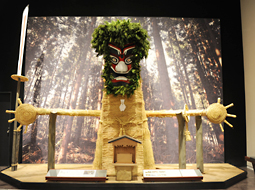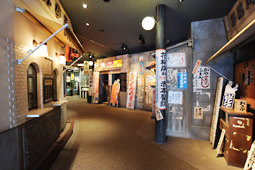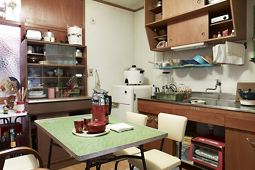 |
|
Here and There introduces art, artists, galleries and museums around Japan that non-Japanese readers and first-time visitors may find of particular interest. The writer claims no art expertise, just a subjective viewpoint acquired over many years' residence in Japan.
|
|
 |
|
|
 |
 |
The National Museum of Japanese History: Everything You Always Wanted to Know
Alan Gleason |
 |
 |
| Entrance to the National Museum of Japanese History, flanked by blooming cherries on an early spring day. Photo by Alan Gleason |
The National Museum of Japanese History succeeds in being both exhaustive and entertaining. This sprawling treasure trove of Japanese history, archaeology, and folklore is practically a stone's throw from Narita Airport and is the perfect place to spend an afternoon during a lengthy layover -- but few tourists are ever apprised of its existence. Most Tokyoites are just as ignorant. With the vast majority of national museums located in the capital, it's easy to overlook this astonishing institution, which sits on a hill in the Chiba countryside an hour out of town.
For my part, I would never have heard of the place were it not for a poster that suddenly appeared in Tokyo train stations announcing the March 19 opening of the museum's newly remodeled Folk Culture section. A bit of research revealed that it is easily accessed from downtown Tokyo: a Narita Airport-bound express train on the Keisei Line will get you to nearby Keisei Sakura Station in less than an hour.
The museum occupies a sizable chunk of real estate on the former site of Sakura Castle, a 15-minute walk from the station. All that remains of the Edo-era fortress is an elaborate maze of earthen ramparts in what is now a lovely park, which proved perfect for strolling on an early spring day when the cherries were blooming. Opened in 1983 in this bucolic setting, the museum houses some 200,000 "artifacts of historical importance and cultural value." It is also a center for research that, as part of an inter-university consortium, runs a doctoral program in Japanese history.
 |
|
 |
| Replica of Rajomon, the gate at the southern entrance to Heijokyo (today's Nara), the capital of Japan from 710 to 784; in Gallery 1. The original was over 20 meters high. |
|
Clothing of nobility during the Heian period (794-1185); in Gallery 2. |
Sakura is a small city a few kilometers southwest of Narita. Why it was chosen as the site for the nation's historical repository of record puzzled me at first, but a helpful curator explained that (a) Sakura has a long history as a home to research facilities in science and medicine; (b) the government already owned the castle grounds, which had been covered by army barracks until the end of World War II; and (c) placing the museum in close proximity to Narita seemed like a surefire way to attract foreign visitors.
Its dearth of publicity notwithstanding, the museum has done its best to make Japanese-challenged visitors welcome. The English website is one of the most thoroughly and well-translated museum sites I have seen in this country. The same goes for the display captions, though these are a work in progress. Recently remodeled galleries, like the one on folk culture, offer translations in English, Chinese, and Korean. Older sections, such as those on ancient and medieval Japan, are at this point still monolingual, which is a pity for non-Japanese visitors given the wealth of information there about the origins of Japanese civilization. Hopefully, with time these exhibits, too, will be translated as generously as the newer ones, and the museum will be able to boast an international ambience second to none.
Even with that minor caveat, I cannot recommend this place highly enough to anyone interested in an overview of Japan through the millennia. Room upon room of big dioramas, wall-sized maps, life-sized dwellings, and scale-model cityscapes -- as well as entertaining displays of the paraphernalia of everyday life as it was lived during vastly different epochs -- make this a visual feast that transcends any linguistic constraints.
 |
|
 |
| Diorama of the downtown district of Edobashi Hirokoji (Great Avenue of Edo Bridge) in 18th-century Edo (now Tokyo), then the world's largest city; in Gallery 3. |
|
O-Ningyo-sama, a guardian deity from the Hoonokibashi district of Fukushima Prefecture; in Gallery 4. Huge straw effigies, some four meters tall, were placed on the outskirts of villages to ward off evil. |
My original plan was to focus my visit on the new Folk Culture section. This turns out, however, to be a mere fraction of the entire permanent exhibition, which occupies six enormous galleries, each the equivalent of a museum in itself. Intending to take a cursory stroll through the first three sections on my way to Gallery 4, home of the Folk Culture exhibit, I wound up spending most of my afternoon absorbed in the maps of early migrations to the Japanese archipelago, colorful dioramas of Jomon and Yayoi villages, and the massive replica of a third-century kofun burial mound in Gallery 1 (prehistoric and ancient Japan), followed by equally vivid and time-devouring depictions of life in medieval and early-modern Japan in Galleries 2 and 3, before finally staggering into Gallery 4 just before closing time.
The "folk culture" on display there was not exactly what I expected. The museum has given the category a clever contemporary twist, showcasing items that one might more readily associate with the term "pop culture." But, why not? Among the exhibits: the world of yokai (a pantheon of indigenous supernatural creatures, most of them malevolent), replete with lifelike figures of same; ancient religious rituals still practiced today, like the Noto Peninsula's Abare Matsuri (literally "raging festival"), in which drunken revelers toss portable shrines into a river; and the most stunning array of plastic food I have ever seen (in a section on Japanese New Year delicacies). The curators clearly had a field day planning and assembling this gallery.
Capping off the tour are Galleries 5 and 6, devoted respectively to the period of modernization from the mid-19th century up to World War II, and the wartime and postwar eras. As with the Folk Culture display, much of the contemporary material is handled with a light and irreverent touch; the museum is clearly unafraid to leaven its more scholarly presentations with plenty of pop. The last exhibit to greet me as I hastened toward the lobby, apologizing to the staff for my tardiness, was a two-meter-high Godzilla.
Whether you are a Tokyo-area resident or a traveler passing through Narita with a few hours to kill between flights, you will not regret a visit to this marvelous institution. If you can, though, try to budget yourself three or four hours to take it all in.
 |
|
 |
| Life-sized reproduction of a street in Tokyo's Asakusa entertainment district during the Taisho period (1912-25); in Gallery 5. Cinemas like the one at left featured silent films; museum visitors can choose among four movies to view here. |
|
Life-sized replica of a typical apartment in a postwar public housing complex, furnished as it would have been in the mid-sixties; in Gallery 6.
All images courtesy of the National Museum of Japanese History unless otherwise indicated.
|
|
|

|
National Museum of Japanese History |
 |
117 Jonai-cho, Sakura City, Chiba Prefecture
Phone: 043-486-0123
Hours: 9:30 a.m. to 5 p.m. (March-September), to 4:30 p.m. (October-February); admission until 30 minutes before closing. Closed Monday, or the following Tuesday when Monday is a national holiday, and 27 December through 4 January.
Transportation: 15-minute walk from Keisei Sakura Station, 50 minutes by express on the Keisei Line from Keisei Ueno Station in central Tokyo or 25 minutes from Narita Airport. |
 |
|
 |
|
|
|
|
 |
Alan Gleason
Alan Gleason is a translator, editor and writer based in Tokyo, where he has lived for 25 years. In addition to writing about the Japanese art scene he has edited and translated works on Japanese theater (from kabuki to the avant-garde) and music (both traditional and contemporary). |
|
|
|
 |
|